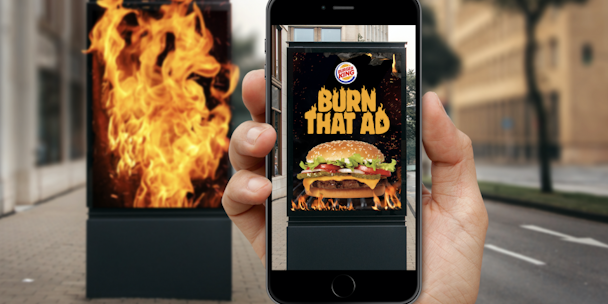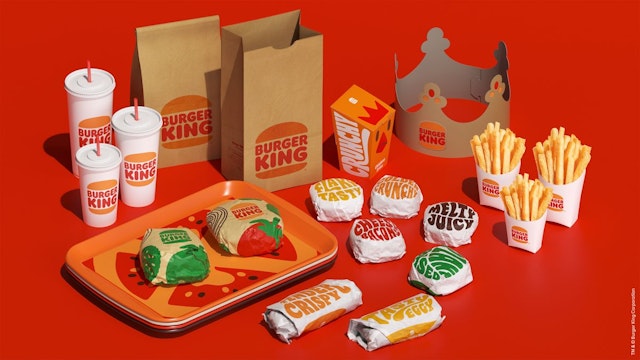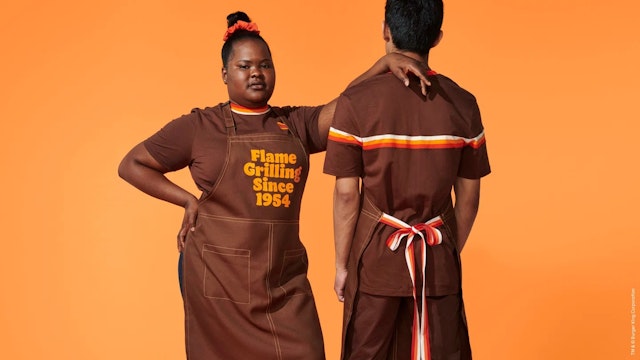
Advertisement

Burger King's 'Burn That Ad' campaign
Burger King has just undergone its first redesign in 20 years, but that’s not all that’s changing for the fast-food giant in 2021. Here, Fernando Machado, global chief marketing officer of parent company Restaurant Brands International, reveals the creative and career lessons gleaned from a critical 12 months and what’s next for the Home of the Whopper.
Forced to close restaurant doors around the world as lockdown restrictions came into force across international markets, Burger King refused to fall into the trap of short-termism and instead spent much of a tumultuous 2020 working on ideas to improve its food quality and brand experience.
Leading the charge on the brand front has been Burger King's global chief marketing officer Fernando Machado, who had no idea of the whopper task he was biting into when he was promoted to the same position for its parent company – adding Popeyes and Tim Hortons marketing to his remit – in January 2020. Now, he’s been nominated for the World Federation of Advertisers (WFA) Global Marketer of the Year award, which is celebrating the work that marketers from around the world have done to strengthen brands and businesses during the pandemic and beyond.
It's been a relentless 12 months for Machado, encompassing the removal of artificial colours and preservatives from Burger King’s menu (which Machado’s team immortalised in the now infamous ‘Mouldy Whopper’ campaign); the unveiling of new physical spaces designed for a post-Covid-19 world complete with ‘touchless technology’; working closely with the company’s food innovation teams on a mission to improve (and safeguard) the consumer experience via multiple ordering and delivery modes, many of which are contactless; and the introduction of a bold new sustainability pledge.
Now, the brand has put a (literal) wrap around the improvements with an upgrade of its own visual identity, which Machado says should help signal to consumers that Burger King is “evolving”. A bold palette and minimalist logo seamlessly pay homage to the fast-food giant’s heritage and its future.
But, even with a shiny new brand, the Home of the Whopper and its sister restaurants are braced for what’s certain to be another uncertain 12 months. Machado believes the lessons he learned in 2020 will help the company navigate the challenges ahead.
“I’m not going to lie to you, when the pandemic first hit, I was in crisis mode,” he tells The Drum.
“We were watching things unfold in the APAC market and bracing ourselves for the impact, but we racked out brains and developed both short-term and long-term solutions that worked for the business.“

With ongoing social distancing restrictions, lockdowns and an overnight switch to delivery, fast-food brands have had to pivot both their business models and their advertising over the past year. KFC dropped its ‘Finger Lickin’ Good’ promise, while McDonald’s has aggressively doubled down on ad spend to promote its takeaway tie-ups.
As the pandemic took hold, Restaurant Brands International relied on a mixture of purpose-driven projects and tactical promotions to help keep its portfolio front of mind for consumers while also making a difference to their daily lives.
When restaurants reopened for delivery and takeout, communications then changed to showcase the procedures in place to protect customers and combat the “uncertainty and fear” Machado was seeing in the market.
“After that, I pushed the team to think about how we could go back to infusing everything we did with the personality of our brands,” says the marketer. “People were in desperate need of a bit of comic relief, and Burger King in particular has a history of providing that. I had CNN on 24/7 and I felt like the world was about to end any second – so I wanted to go back to doing things that framed the pandemic in a positive context and put a smile on people’s faces.”
Executions included Burger King Italy’s ‘Social Distancing Whopper’ (a burger with extra onions which promised to ‘keep people at bay’ in lieu of a face mask) and a half tongue-in-cheek call for UK customers to ‘Order from McDonald’s’ because: ‘restaurants employing thousands of staff really need your support at the moment.. Getting a Whopper is always best, but ordering a Big Mac is also not such a bad thing.’
Amid all this though, the brand has kept one eye on re-engineering its proposition for the future, instead of being blinded by impulsive thinking.
Machado hopes all the brands in his roster continue to operate this way, with support from the dozens of creative and media agencies it works with at a global and regional level – the list of which includes Crispin Porter + Bogusky, BBH and Wunderman Thompson.
“I want us to continue doing a good job of balancing the long with the short term. It’s very tempting to focus on what’s right in front of you in a moment of crisis, it’s natural. As a marketer you’re probably focused on survival rather than a project that might have a positive impact for your brand three or five years down the line but chief marketing officers have to do both.
“In March, April and May we were thinking short-term but throughout the year we’ve been able to strike a better balance and we need to keep that momentum going.”

It’s certainly not been plain sailing for Machado’s team in a tough climate, however. Lockdowns have entered their second and third stages across much of Europe and the US in recent weeks, which will only exasperate sales declines.
In October, Restaurant Brands International reported that quarterly revenues had fallen 8% as Burger King and Tim Hortons sales struggled to bounce back from the pandemic. Popeyes, however, bucked the trend with positive same-store sales growth to the tune of 17.4% over the same time period.
Despite the downturn, the company is still investing in its restaurant footprint for the future. It recently announced plans to revamp thousands of its drive-thru lanes across the three brands, starting with 10,000 Burger King and Tim Hortons locations globally. Contactless payment methods and digital menu boards that change display options based on weather, previous orders and other factors are among the planned updates, with Burger King’s drive-thru sales having climbed 28% in Q3.
As vaccine rollout programmes begin though, the marketing boss is ever optimistic. “Hopefully throughout the year we’ll see consumer routines return to a pattern that’s closer to 2018, which I think will help the whole industry and the economy in general bounce back.”
The biggest lesson learned for Machado in a year of crisis has been the recognition that the chief marketer role is changing.
“In the past, the chief marketing officer was the ‘marketing person’ tasked with creating the brand and driving demand. The role of the chief marketing officer now is to do a progressive job and sit on the sustainability and diversity teams and ensure the brand touches every part of a business.
“My leadership role has taken on new elements in a moment of crisis, I play a much more active role in everything. I don’t just wear my marketing hat, I’ve had to deal with supporting staff in working from home and supporting my peers on decision making around sustainability. That’s really important for any top marketer.”
You can vote for Machado, or the other finalists for the WFA Marketer of the Year Award, here.